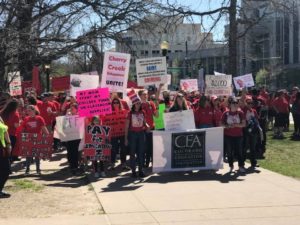‘Power and control’: Why liberals act like fiscal conservatives when school choice is on the table
Opponents of education freedom have long claimed such programs are too expensive and will “defund” public education.
Now that Arizona, the first state to implement universal school choice,…

Opponents of education freedom have long claimed such programs are too expensive and will “defund” public education.
Now that Arizona, the first state to implement universal school choice, has a multimillion-dollar budget deficit, choice opponents might appear to have their smoking gun.
One Idaho commentary even called the situation “Arizona’s cautionary tale that Idaho lawmakers can still avoid repeating.”
“[Arizona] is heading into a fiscal twilight zone thanks to the misguided decision two years ago to expand its Empowerment Savings Account (ESA) to every student and the skyrocketing expense of its longtime voucher tax-credit program,” the commentator wrote.
Not so fast.
True, enrollment in the Grand Canyon State ESA program did jump from less than 10,000 in 2021 to more than 70,000 in 2023. But seeing as how choice scholarships have an average value of $9,500, and the state’s per-pupil public school funding will soon exceed $14,500, it’s hard to justify the argument that school choice is too costly.
Nevertheless, left-wing Arizonans are arguing it anyway.
Last July, Democrat Gov. Katie Hobbs reported the ESA program had spent $943 million serving 8% of the state’s students. Hobbs called the spending “unsustainable” and even claimed it would “bankrupt our state.”
Comparatively, the state spent $11.6 billion on public education in 2022; 8% of $11.6 billion is $928 million, roughly the same amount spent by the ESA program.
But education policy experts explain that school choice has nothing to do with Arizona’s budget woes.
Matt Beienburg, director of education policy at the Goldwater Institute, told The Lion:
“For years, the left has warned that school choice would trigger the catastrophic defunding of public schools. Yet in Arizona, public school funding per pupil has continued to soar even as the state’s ESA program has exploded in popularity. So instead of claiming that school choice will bankrupt public education, the left is now trying to convince lawmakers it will bankrupt their entire state. Yet again, as shown in Arizona, where the state is experiencing a significant financial deficit, the K-12 education formula responsible for funding district schools, public charter schools, and ESAs is actually running a surplus for the state as more students opt for an ESA rather than a higher-cost public school education.”
The left isn’t often known for being the most fiscally responsible crowd, especially when it comes to education spending. Politicians and special interest groups such as teachers’ unions are perpetually lobbying for more money to complete the mythical quest for “fully funded education.”
On a national level, they will spend hundreds of millions on mental health and billions on student debt relief. But the minute school choice enters the picture, they become fiscally conservative penny pinchers of whom Ebenezer Scrooge would be proud.
Why change their tune now? Turns out it’s not about the money.
Beienburg continues:
“The left’s priorities have nothing to do with responsible fiscal stewardship or student achievement, and everything to do with power and control. The same political activists now trying to smear the finances of school choice programs are the very same ones who locked kids out of class during COVID and then demanded taxpayers pour $200 billion of deficit spending into public schools to undo the damage those lockdowns caused. As we’ve seen in states like Arizona, union-aligned interest groups howl at the “cost” of educating a student through private choice programs like the Empowerment Scholarship Account (ESA), but happily celebrate taxpayers spending twice that amount if the child instead enrolls in a public school.”
Last winter, Illinois proved just that.
State lawmakers allowed a school choice program to sunset, even though it served nearly 10,000 low-income students with 24,000 more on a waitlist. The tax-credit program, Invest in Kids, was much cheaper than Arizona’s ESA, costing the state just $57 million.
For context, Illinois’ overall education budget is nearing $11 billion. And its budget gets annual $350 million increases, which Democrat J.D. Pritzker might increase to $550 million to make up the gap left by pandemic-era dollars.
Invest in Kids wasn’t bankrupting the state, but it did what every school choice program in the nation will inevitably do – take power away from unions and those who benefit financially and politically from the monopoly of public education.
“Democrats [are] a lot less likely to support school choice policies,” explained school choice expert Corey DeAngelis, “because their campaign contributions disproportionately come from the teachers’ unions who are fighting to protect their monopoly.
“For a long time in K to 12 education, the only special interest group was essentially the teachers’ union and the superintendent unions, the employee unions. But now we have this new special interest group emerging, these parents who want more of a say in their kids’ education.”
States aren’t just responsible for funding the traditional, government-run common schools. They are responsible for providing for the education of the public (read: the people), wherever that education happens to occur.
If parents use state dollars to send their children to a private school, the state is still providing for the education of that child.
It’s just a better education at a lower cost.



